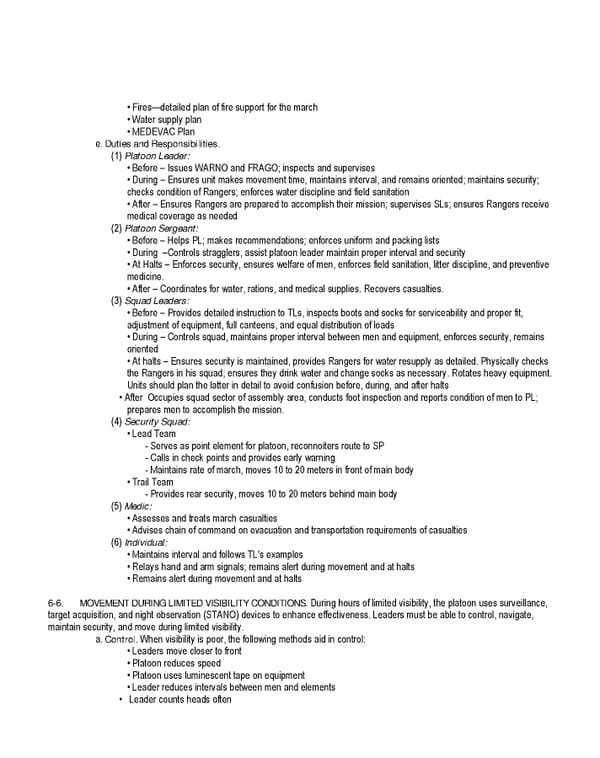• Fires—detailed plan of fire support for the march • Water supply plan • MEDEVAC Plan e. Duties and Responsibilities. (1) Platoon Leader: • Before – Issues WARNO and FRAGO; inspects and supervises • During – Ensures unit makes movement time, maintains interval, and remains oriented; maintains security; checks condition of Rangers; enforces water discipline and field sanitation • After – Ensures Rangers are prepared to accomplish their mission; supervises SLs; ensures Rangers receive medical coverage as needed (2) Platoon Sergeant: • Before – Helps PL; makes recommendations; enforces uniform and packing lists • During –Controls stragglers, assist platoon leader maintain proper interval and security • At Halts – Enforces security, ensures welfare of men, enforces field sanitation, litter discipline, and preventive medicine. • After – Coordinates for water, rations, and medical supplies. Recovers casualties. (3) Squad Leaders: • Before – Provides detailed instruction to TLs, inspects boots and socks for serviceability and proper fit, adjustment of equipment, full canteens, and equal distribution of loads • During – Controls squad, maintains proper interval between men and equipment, enforces security, remains oriented • At halts – Ensures security is maintained, provides Rangers for water resupply as detailed. Physically checks the Rangers in his squad; ensures they drink water and change socks as necessary. Rotates heavy equipment. Units should plan the latter in detail to avoid confusion before, during, and after halts • After Occupies squad sector of assembly area, conducts foot inspection and reports condition of men to PL; prepares men to accomplish the mission. (4) Security Squad: • Lead Team - Serves as point element for platoon, reconnoiters route to SP - Calls in check points and provides early warning - Maintains rate of march, moves 10 to 20 meters in front of main body • Trail Team - Provides rear security, moves 10 to 20 meters behind main body (5) Medic: • Assesses and treats march casualties • Advises chain of command on evacuation and transportation requirements of casualties (6) Individual: • Maintains interval and follows TL's examples • Relays hand and arm signals; remains alert during movement and at halts • Remains alert during movement and at halts 6-6. MOVEMENT DURING LIMITED VISIBILITY CONDITIONS. During hours of limited visibility, the platoon uses surveillance, target acquisition, and night observation (STANO) devices to enhance effectiveness. Leaders must be able to control, navigate, maintain security, and move during limited visibility. a. Control. When visibility is poor, the following methods aid in control: • Leaders move closer to front • Platoon reduces speed • Platoon uses luminescent tape on equipment • Leader reduces intervals between men and elements • Leader counts heads often
 Ranger Handbook Page 105 Page 107
Ranger Handbook Page 105 Page 107